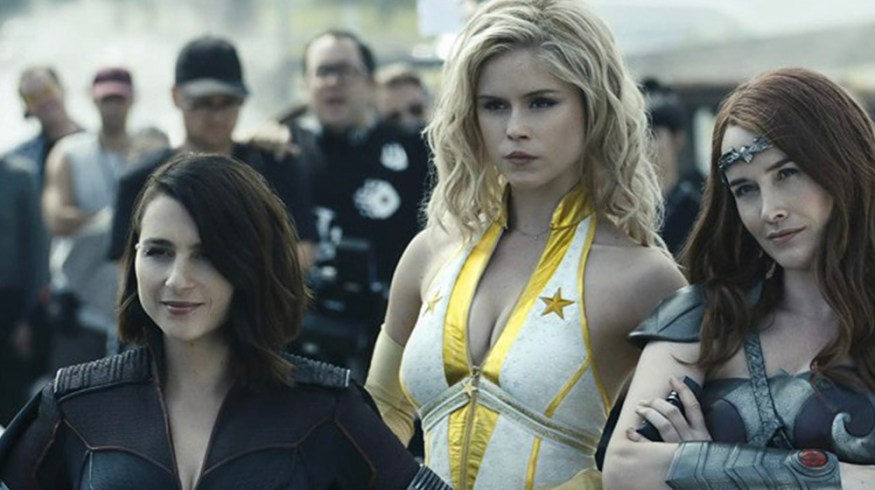
6 Modern TV Shows and Movies that Mix Genres
Shows and movies that mix different genres often produce captivating content that feels fresh, pushing the envelope on how stories can be told. Here are some notable examples you can watch today.
It seems that with all the new streaming platforms and networks, there’s just too much content releasing all the time. New shows have to be better than good to rise above the maelstrom of just-okay content, which gets harder to do. As a consumer, keeping up with the newest show or movie is exhausting. It’s not possible to watch everything.
Lately, however, I’m more interested in series or movies that reinvent or reinvigorate an established genre and breathe new life into it. I can’t watch another cookie-cutter superhero movie or another comedy about high school antics portrayed by 30-year-olds. I want something new, fresh, and willing to go against the grain. I don’t think I’m alone. Below is a list of shows and movies that take an established genre and add something new.
(Spoiler Warning: There may be slight spoilers for the shows and movies below.)
The Superhero One: Thor: Ragnarok
In the span of a few years, Thor went from one of the MCU’s least exciting properties to one of the best Avengers by flipping the character, and the superhero genre, on its head. It’s not important to retell Thor’s exploits from his first two movies, as they are inconsequential to the current Thor. In fact, don’t even watch the first two.
In Thor: Ragnarok, the titular character is changed. He’s still the same cocky superhero/god, but he’s also funny, using his wit and sarcasm to spar with friends and villains alike. The big, dumb jock energy that Thor leaned into in his first two movies is gone, replaced by a more affable, self-aware hero.
After losing his dad, confronting a sister he didn’t know about, losing Mjölnir, and being captured on a strange planet, Thor is a character forced to confront his old identity. By the end of the movie, he’s reinvented himself out of necessity. The movie makes a few obvious nods to his transformation in the way of his physical appearance, shedding the sleeves on his armor and his signature golden locks for something more modern and edgy. And although he loses his trusted Mjölnir, he gains a power worthy of the god of thunder. But the ending truly encapsulates a character who has undergone a significant change: To save his people from Ragnarok, he must sacrifice his home, which is his to rule.
Taika Waititi, the movie’s director, is the master of turning weird, outlandish concepts — his Jojo Rabbit is another film that could easily be on this list — into mainstream darlings. While other Disney-made Marvel movies follow a similar formula, Thor: Ragnarok flips the superhero genre on its head by incorporating a space-faring story into a world revolving around Norse mythology. In this movie, Thor is not an all-powerful god; he’s a god defeated, forced to fight for a despot and given the insurmountable challenge of single-handedly defeating a sibling whose power is far beyond his own. This is not your typical Marvel movie, and it finally gives such an awesome hero a proper introduction into the MCU. The film is also hilarious — the scene at the top of this section takes place at the beginning of the movie and sets the tone.
The Animated One: Your Name
Anime can be very formulaic, so many don’t see the medium as a serious vehicle for fantastic storytelling. However, Your Name is unlike many of its contemporaries; there are no amazingly overpowered high school-aged kids defeating comically-evil villains in overwrought fights. Your Name is a story of love that takes place across different timelines. It mixes romance and fantasy with a time-traveling twist that pays off extraordinarily.
The movie takes place in Tokyo, and it follows two high school-aged students. Mitsuha lives in a rural part of Japan and is bored with her quiet life. Taki lives an opposite lifestyle in Tokyo, juggling school, a job, and spending time with friends at nice cafes. Before long, the two teenagers, who have no previous ties to each other, begin to wake up in each other’s bodies at different periods in time. Taki is living three years in the future, however, which both of them are not aware of somehow. Although the two only meet briefly, they develop feelings for each other by the end, but their future is put on the line when a catastrophic event befalls Mitsuha’s town.
I don’t want to spoil the ending, but the payoff is so huge that you can’t help but get emotional. When I say that people were straight-up sobbing uncontrollably in the theater, I am not exaggerating. Those that don’t take anime seriously should watch this movie before condemning the medium as childish. I know time travel always complicates a plot, but Makoto Shinkai — the writer and director of the film — weaves elements of fantasy and time travel into a high school love story that will continue to inspire new fans for years to come.
The Alien Sci-Fi One: Arrival
In the vein of other aliens-visit-earth movies, a college professor is plucked from obscurity and placed front and center in the government’s effort to understand what’s going on. Louise Banks is that professor, a linguist, whose job is to find a way to communicate with the just-arrived aliens. Where other movies might depict humanity at war with the aliens, Arrival focuses on the complex task of deciphering what the aliens want, which they can’t do until they learn to communicate with each other. The task is not easy, and the movie moves slowly, mostly focusing on Louise’s attempts at communicating with the aliens, which they call heptapods because of their seven limbs.
The mood is tense for most of the film, accentuated with moody blue-ish gray skies, muted tones, and unsettling, synth-heavy sci-fi music. The scenes where Louise’s team communicates with the heptapods inside their ship are especially tense and chilling, with cavernous black walls leading to a glowing white rectangular window pane in which the heptapods hide behind. Although it feels like things could turn at any second, they never do. The aliens’ massive size and creepy tentacles are off-putting, sure, but the most unsettling part comes later, when a miscommunication sets the world’s governments on edge, putting humanity one step closer to war with the heptapods. It’s not until Louise finally understands the heptapod’s complex circular language that she starts to see the past, present, and future as one. Her newfound gift helps her deescalate the situation, but there is a darker truth to her being able to see her future.
The director of the movie, Denis Villeneuve, is one the best directors to emerge in the last five years, and among all of his recent films — Prisoners, Sicario, Blade Runner 2049 — this is his most cerebral. The movie is based on Ted Chiang’s excellent short story “Story of Your Life,” but the film expands on the short story to perfection. It has the right elements of sci-fi but with none of the weird science and space marines. It’s a slow-burning, smart movie that’s not afraid to introduce complicated topics. It shows that humanity, when scared and confused, will resort to violence as a last defense but that there is also hope when cooler heads can prevail and introduce reason. The best compliment I can dish is that I couldn’t stop thinking and talking about this movie after leaving the theater, and it continues to amaze me on every subsequent watch.
The Space Sci-fi One: The Expanse
With humanity colonizing the outer reaches of our solar system, The Expanse offers a glimpse of a not-so-distant society where the inner planets — Earth and Mars — primarily benefit from the hard labor of Belters, the people living in space stations millions of miles away. The Expanse, which first debuted on Syfy, is based on the books written by James S.A. Corey, which is a pen name used by the two authors, Daniel Abraham and Ty Franck.
The Expanse’s first season slowly introduces the viewers to a space-faring society living on a tenuous peace between Earth, Mars, and the Belt. Earth is overpopulated, and most people live in poverty because there are not enough jobs to go around. Mars is a Spartan society with an impressive military and the most advanced weapons and ships in the system. The Belt is made up of impoverished, blue-collar workers living on various space stations, moons, and asteroids around the system’s edges. All three groups hate each other, but the inciting incident in season one sets everyone on edge. It soon becomes a show with awesome, realistic space battles, political theatre, and murder mystery. It has a little bit of everything for everyone, but it becomes more intriguing when a strange alien substance appears, putting humanity in danger. The show follows the crew of the Rocinante, a detective on the Ceres space station, and United Nations politicians on Earth, among others.
Where The Expanse differs from other space shows is that it feels more true to real life. Ships are made practically and don’t use plasma cannons; passengers must wear magnetic boots when in space; those who aren’t born on Earth experience gravity sickness, leading to death. The show pays a lot of attention to detail, such as how Belters speak a patois built on English that borrows heavily from other languages.
The Expanse is a special show for many reasons, but it can’t be put in any box. While its later seasons explore the alien substance in depth, The Expanse shows humanity on the brink of an all-out space war; it’s a commentary on corporate greed, political ambition, and our desire to explore the unknown. It doesn’t have the lore of Star Wars or the science of Star Trek, but The Expanse is a show that continues to defy expectations even after it was canceled and brought back by Amazon.
The 1950s Horror One: Lovecraft Country
Lovecraft Country is supposed to be a horror show. There are jump scares, creepy monsters, and tense scenes in the very first episode, but the new HBO show, which takes place in the US during the 1950s, portrays a horror show with a thick layer of Jim Crow-era racism that is more horrifying than the actual monsters.
The show’s opening scene is a grandiose panorama, encompassing tropes from sci-fi to horror to fantasy, with the doe-eyed protagonist wandering a hellish battlefield. While that scene, in which a famous tentacle-faced Lovecraft monster makes an appearance, is a sight to behold, the main character, Atticus Freeman, is immediately pulled into the real world, a place where Black people have to sit in the back in the bus. A place where racism is alive and well.
The show is based on a book by the same name written by Matt Ruff, and it explores horror themes created by H.P. Lovecraft, a huge racist. It’s no coincidence that a show named after the infamous author name has a majority Black cast or that the show is set in a violently racist period in American history. This being a horror show, there are monster-chase scenes, but it’s the racism that’s genuinely terrifying.
In the first episode, the three main characters are on a mission to find Atticus’ dad, who has run off to Lovecraft Country on a mysterious errand. On their way there, as they stop at a diner to eat lunch, the trio is chased out of town by a group of gun-toting racists. Later, they are accosted by a white policeman who immediately escalates the situation and threatens them to leave his town by sundown. Tailed by the police officer, they keep the speed limit and barely make it out of town, but they are met by other police blocking the road. That’s when the show takes a turn. The police take the group into the woods, but a huge, terrible beast with eyes placed all over its body attacks them. Though the monsters are scary, my heartbeat was racing much more as the trio raced out of town before sundown.
There are even more monsters and magic and other weird fantasy in later episodes, but, similar to Get Out — Jordan Peele is involved in this show, too — racism plays a crucial part in the horror. For Black people living in America, the real boogeyman is not the one hiding in the woods. It’s the one hiding in plain sight.
The Anti-Superhero One: The Boys
(Warning: The trailer below does contain expletives and graphic scenes involving blood and gore.)
Based on Garth Ennis’ comic books, The Boys follows a team of people — mostly men — who have one thing in common: their hate in superheroes. After Hughie loses his girlfriend in a freak superhero accident, he is recruited by Billy Butcher for a mission. With his life changed, Hughie joins Butcher’s team after the mission, and they attempt to take down the most famous superheroes, who are funded by the evil Vought, a giant superhero corporation.
In The Boys’ world, superheroes are not the do-gooders from the pages of Marvel or DC comic books. They are greedy, narcissistic people with superhuman abilities who have no compassion for regular people. While their abilities make them unique, superheroes in The Boys spend most of their time as celebrities, appearing in movies, on food packaging, and merch. They are stage-managed in every aspect. They are not heroes; they are the products of a giant corporation, which makes them utterly terrible. Early on, we learn that A-Train, the hero responsible for killing Hughie’s girlfriend, is not at all remorseful for his actions. It becomes apparent that A-Train is not an exception — all heroes in The Boys are anything but.
Now in its second season, the Eric Kripke-run show has gone even further, with gory over-the-top scenes that are unlike anything else in popular television. This is not what a superhero show is supposed to be like, which is why it’s such a beloved show. While the comics inspire the show’s graphic violence, The Boys TV series takes a different direction in executing the larger story. The comic’s overall tone is still there, especially the dark humor, but the plot has been reshaped to fit within eight, one-hour episodes per season. The result is a scathing indictment on the superhero genre and a somber look into what our world would like if superheroes were real and owned by corporations. However, the irony is that the boys are the heroes’ foil and the true heroes of the story. They may be unorthodox and prone to excessive violence, but with superheroes’ inherent impunity, the boys are the only deterrent.
What to Stream
It wasn’t easy narrowing down these shows and movies, but it’s nice to know that there is still plenty of great content out there. Tiring as it may be to find something new to watch on Netflix, there are many gems out there if you know where to look.
As someone who is always in the mood to watch The Office or Brooklyn 99, I like finding new shows that tackle difficult subjects, highlight marginalized creators, or incorporate different genre aspects to create a melting-pot of binge-worthy content. So, don’t be afraid to try something new. Sometimes, it’s the most unexpected mashup of ideas and genres that ends up being the most fun to watch.
Here’s some more filmmaking/pop culture content we think you’ll like:
- A Study of Unreliable Narrators Throughout Film History
- How Filmmakers Use Allegory in Film and Video Projects
- The Do’s and Don’ts of Writing a Tagline for Your Film or Video Project
- The Never-Ending Discussion: Practical VFX vs. CGI
Cover image featuring The Boys via Amazon.




